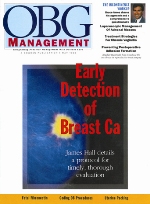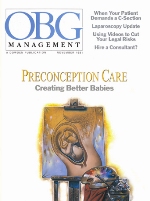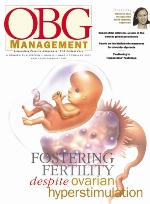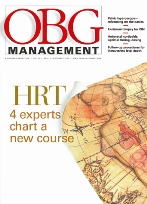This issue of OBG Management concludes its 20th full year of publication. We think this a historic moment—not just because it’s a milestone in our efforts to elevate the richness of the care that you provide, but also because, during those 20 years, the practice of obstetrics and gynecology has evolved so significantly.
We’ve seen major changes in our understanding of disease processes; in approaches to professional practice; in the growth of a global medical community; and in the evolution of electronic networks that are drawing patients and physicians closer to each other. The list goes on; the box notes a few more of the events and trends that have colored the past 20 years of medicine.
I’m using this space, this month, for twofold purpose:
First, I thank you, heartily, for your loyal readership, your letters, and your suggestions for making OBG Management relevant to your work. All this indicates that we are succeeding at our goals (stated on each issue’s Masthead) of enhancing the quality of care that you give and contributing to your professional development. In every issue, and with every posting to our Web site, we strive to achieve these goals by providing useful and clear education and offering you the opportunity to interact with us and your peers.
Second, I take a peek at what I see as facets of the future of ObGyn—developments that seem particularly likely to continue to shape our work.
It’s research that drives how we diagnose
and treat disease
Consider a single example: In 2008, Dr. Harold zur Hausen shared the Nobel Prize in Physiology or Medicine for his discovery, in the 1980s, that oncogenic human papillomavirus (HPV) subtypes, including 16 and 18, cause most cases of cervical cancer. His work opened the door to better diagnostic testing (for oncogenic HPV subtypes), new paradigms for screening and assessment of disease, and a vaccine.
Without question, worldwide application of a vaccine against oncogenic HPV subtypes is going to markedly advance women’s health. Dr. zur Hausen’s accomplishments, and how the diagnosis and treatment of cervical disease were transformed as a result, underscore my point: Research is the fundamental process that transforms and advances medical care.
What’s next? Dozens of pressing clinical problems still need to be solved by the medical research community. These include the causes and treatment of preterm birth, newborn neurologic injury, preeclampsia, diabetes, hypertension, endometriosis, fibroids, breast and ovarian cancers, and urinary incontinence.
Technology changes our practice
In 1989, 70% of hysterectomy procedures were performed through a laparotomy incision. Will the great majority of hysterectomy procedures in the near future be performed by a laparoscopic approach? Although laparoscopic gyn surgery is more demanding, technically, and requires more surgical equipment, it has clearly been shown to reduce recovery time and return to daily activities and work.
The potential for performing most hysterectomy procedures through the laparoscope has depended, in part, on novel surgical equipment, including the Harmonic Scalpel and LigaSure, Gyrus, and EnSeal devices (see Dr. Barbara S. Levy’s “Update on Technology” on tissue-cutting and -sealing devices for laparoscopic surgery), that makes it easier to perform safe laparoscopic hysterectomy reliably.
New technology is likely to continue to transform practice (see Dr. Jon Einarsson’s review of barbed material for laparoscopic suturing, for example). This likelihood raises important questions for clinicians: How are we going to continually refresh our skills as new technology is introduced? And, taking a broader view, will any piece of new technology increase or reduce the cost of health care to society?
At OBG Management, our print edition and our expanding, interactive electronic resources (including www.obgfindit.com) will, we hope, play an important role in helping you stay current with evolving medical technology.
SNAPSHOT: 20 years of ObGyn practice, 20 years of publishing
MAY 2008Changes in birth The cesarean delivery rate declines through the late 1980s and early 1990s due, in part, to increasing use of trials of labor after cesarean delivery (TOLAC). Then, in the late 1990s, with a decline in TOLAC, the cesarean delivery rate rises markedly. Finally, the cesarean rate starts to stabilize in the late 2000s. | FEBRUARY 2009Changes in girth The US population—including our patients—becomes increasingly obese: Between 1980 and 2004, the obesity rate doubles. In 2005 and 2006, more than one third of adults—72 million people—are obese. | MAY 1998Mammography on the rise The use of mammography increases markedly. In 1987, only 39% of women older than 40 years had a mammogram in the prior 2 years; by 2005, that percentage was 66%. |
SEPTEMBER 1998Imaging proliferates Imaging technology rapidly advances; more patients than ever undergo computed tomography scanning and magnetic resonance imaging—often potentially unnecessary. Health insurance companies respond by imposing precertification review to try to reduce the use of expensive scans. | NOVEMBER 1991The youngest remain at risk Infant mortality declines steadily until 2000—then stays on a plateau. | FEBRUARY 2002ART offers hope Assisted reproductive technology becomes more successful, and more widely used. In 1985, the live birth rate for each in-vitro fertilization cycle initiated was approximately 4.5%; in 2006, that rate was reported to be approximately 40% for women older than 35 years. |
JANUARY 2001Antibiotics fall short The prevalence of drug-resistant bacteria increases sharply. | SEPTEMBER 2002HT loses luster Use of hormone therapy by postmenopausal women decreases sharply after the Women’s Health Initiative report describes serious associated risks. | OCTOBER 2006Bioethics takes to the street Stem-cell and cloning research intrigues and worries the American public. A patchwork of state and federal legislation and regulation follows—expressing condemnation, advocacy, and all moral positions in between. |











